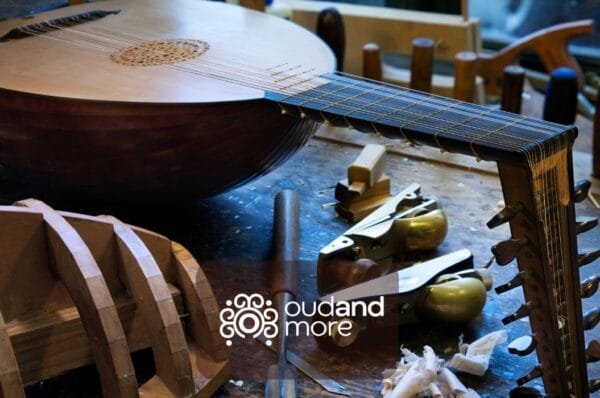Understanding the Oud: A Brief Introduction
The oud is a traditional string instrument that has played a pivotal role in the music of Middle Eastern cultures for centuries. Its origins can be traced back to ancient civilizations, with evidence suggesting that the oud was present in the Mesopotamian region over 5,000 years ago. The instrument has since evolved, becoming a fundamental component of Arab music. The oud differs significantly from other string instruments such as the lute or guitar, mainly due to its distinct shape and the absence of frets. This fretteless design allows for a greater range of melodic expression, making it particularly appealing to musicians who wish to explore microtonal scales commonly used in Middle Eastern music.
Culturally, the oud holds immense significance in various Middle Eastern societies. It is often regarded as the “king of instruments,” a title that reflects its esteem in both solo and ensemble performances. Musicians admire its rich, warm tones, which evoke deep emotions and convey intricate stories. The oud’s versatility allows it to blend seamlessly with various musical styles, whether traditional or contemporary, and it often serves as a lead instrument in diverse ensembles. The instrument is not only a tool for performance but also a means of cultural expression, frequently featured in weddings, celebrations, and religious ceremonies.
Moreover, the unique sound of the oud has led to its adoption beyond traditional boundaries, influencing genres like jazz and fusion music. This adaptability demonstrates the oud’s relevance in a modern musical context. By understanding the historical and cultural aspects of the oud, beginners can appreciate its significance and develop a deeper connection with this remarkable instrument. The oud awaits those willing to master its strings, promising a richly rewarding musical journey.
The Anatomy of the Oud
The oud is a captivating string instrument widely recognized for its rich sound and unique construction. To appreciate its beauty and tones, one must understand its various components, which play a significant role in its overall sound and playability. The main parts of the oud include the body, neck, strings, fingerboard, and pegbox, each contributing to the instrument’s character and functionality.
The body of the oud, often referred to as the resonance chamber, is typically made from wood such as walnut or maple. Its shape and size directly affect the overall volume and tonal quality of the oud. A deeper body generally offers a more profound bass response, while a shallower body can produce brighter tones. The wood type also plays a crucial role in determining the instrument’s sound; for instance, softer woods may yield warmer tones, while harder woods can enhance brightness.
The strings, usually made from nylon or gut, are vital to the oud’s sound production. The number of strings can vary, but most traditional ouds have eleven strings grouped in five courses with an additional bass string. The gauge and material of the strings significantly influence the tuning stability and the warmth of the tone.
Lastly, the fingerboard of the oud, where the player presses the strings, is integral to achieving precise notes. The materials used and the fingerboard’s construction can enhance playability and durability. Understanding these components helps musicians make informed choices when selecting an oud, ensuring they choose an instrument that meets their desired sound and playability criteria.
Types of Tuning for the Oud
The oud, a traditional string instrument, features a variety of tunings that reflect its rich cultural heritage and diverse musical traditions. Understanding the different types of oud tunings is crucial for anyone wishing to explore the vast landscape of oud music. The most common tuning for the oud is known as “standard tuning” which is typically set to C-G-D-A. This configuration allows for a broad range of notes and makes it suitable for a variety of musical styles.
In addition to standard tuning, there are several regional variations that artists may adopt. One example is the “Turkish tuning,” which is slightly higher at D-A-D-G, providing a sharper tonal quality. This particular tuning is prevalent in Turkish folk music and is often used in pieces that require a bright, lively sound. Furthermore, the Arabic tuning system introduces the “maqam” concept, where specific modal scales dictate the performance of traditional pieces, enhancing the emotional expressiveness of the music.
Each type of oud tuning holds significant importance, as it directly influences the melodies and rhythms that can be produced. For instance, the “Hijaz” maqam, commonly associated with Arabic music, allows for a unique sound that evokes a sense of nostalgia. Artists often utilize this tuning in the performance of classic compositions, thereby preserving the cultural essence while promoting musical innovation.
Moreover, lesser-known regional tunings such as the Armenian tuning offer alternative sonic possibilities and can serve as a bridge between traditional and contemporary styles. Musicians who experiment with these tunings expand their repertoire and engage with music in a multidimensional way. Exploring various oud tunings enables players to deepen their understanding of musical theory while enhancing their creative expression.
Common Oud Tunings for Beginners
The oud is a richly resonant string instrument that plays a central role in Middle Eastern music. For beginners seeking to master the oud, understanding common tunings is essential. Among the various tunings available, two of the most accessible ones are the Hijaz and Nahat tunings, which provide an excellent foundation for novice players.
The Hijaz tuning, often used in Arabic music, employs the notes of the Hijaz scale. This tuning typically runs from the lowest string (C) to the highest (A), with the strings tuned as follows: C, G, D, A, and E. This particular arrangement allows players to explore a range of melodic possibilities, making it a popular choice for beginners. To achieve Hijaz tuning on a standard oud, it is crucial to ensure that your strings are properly tightened to the specified notes. Regularly checking the tension can prevent issues associated with string breakage and ensure a clear sound.
Another recommended tuning for beginners is the Nahat tuning. This tuning configuration is known for its versatility and ease of play, especially for those just starting their oud journey. The Nahat tuning typically utilizes the notes C, G, D, A, and F#, aligning the strings in a manner conducive to playing simple melodies. Beginners may find this tuning helpful for developing their skills and gaining confidence. When choosing strings for Nahat tuning, consider options made of nylon or gut, as these materials provide a warmer tone and greater ease of play. Maintaining the oud’s strings by keeping them clean and well-lubricated can also enhance performance and longevity.
By familiarizing yourself with these common oud tunings, novice players can significantly expand their musical horizons. With consistent practice and attention to string choice and instrument care, achieving a beautiful sound on the oud is well within reach for those just starting out.
Choosing the Right Oud for You
Selecting the right oud is a crucial step for any beginner aiming to master this beautiful string instrument. The oud, known for its distinctive sound and rich cultural heritage, comes in various shapes, sizes, and materials, which can significantly influence your playing experience.
First and foremost, consider your budget. Ouds are available at various price points, from affordable models designed for beginners to professional-grade instruments that can be quite expensive. Generally, it is advisable to start with an oud in the mid-range price category, as this will provide a good balance between quality and affordability. This investment will ensure you have a well-constructed instrument that is suitable for learning without breaking the bank.
Size is another important factor. Ouds come in different sizes, and choosing the right one can enhance your comfort while playing. A standard oud is typically around 60 to 75 cm in length, but there are smaller options available for children or those with smaller hands. When selecting an oud, ensure it feels comfortable to hold and play, as this will encourage practice and skill development.
The choice of wood materials can also impact the sound quality of the oud. Traditional ouds are often crafted from solid woods such as mahogany, walnut, or rosewood, each contributing to the tonal richness of the instrument. Be sure to examine the craftsmanship as well; an oud with good construction will have better resonance and longevity. Look for instruments with a smooth finish, well-aligned frets, and sturdy tuning pegs.
Finally, whenever possible, test the oud before making a purchase. Strumming a few notes can help you assess the instrument’s sound quality and playability. If you have the opportunity, seek guidance from experienced oud players or music store professionals, as they can offer valuable insights and recommendations tailored to your individual needs.
Tuning Techniques and Tools
Tuning the oud, a stringed instrument integral to Middle Eastern music, can be accomplished through a variety of techniques and tools. Each method caters to different preferences and levels of expertise. A primary approach involves the use of electronic tuners, which offer high precision and convenience. These devices detect the pitch of each string and provide visual feedback, helping musicians achieve accurate tuning with minimal effort. Electronic tuners often offer various tuning modes, accommodating different preferences and making them suitable for beginners.
Another popular tool for oud tuning is the clip-on tuner. These compact devices attach directly to the instrument’s headstock, allowing them to sense vibrations from the strings. Clip-on tuners are particularly advantageous for outdoor performances or noisy environments, as they can function effectively without background interference. The visual display of a clip-on tuner is user-friendly and encourages a smooth tuning experience.
For those interested in traditional methods, many oud players prefer to tune their instruments by ear using a reference pitch, such as a piano or another oud. This technique involves adjusting the strings to match a specific note, which is often based on the maqam system that governs the music of the region. While mastering this method may take time and practice, it fosters a deeper connection with the instrument. Another traditional approach includes the use of harmonics, where players lightly touch the strings at specific points to find pitches that resonate harmonically.
To properly tune the oud, start by selecting your preferred method and tool. Ensure the instrument is properly placed and that its strings are warmed up. Begin tuning the lowest string and work your way up, making small adjustments until each string is in harmony. Regular practice will not only help maintain optimal tuning but also improve your overall musical skills.
Common Mistakes to Avoid When Tuning an Oud
Tuning an oud can be a challenging task for beginners, and various missteps can hinder the process. One of the most frequent pitfalls is over-tightening the strings. It is essential to remember that the strings are under considerable tension, and excessive tightening can lead to potential damage, including broken strings or even structural issues with the instrument itself. Beginners should approach string tension with caution, gently adjusting the tuning pegs in small increments while regularly checking the pitch. This gradual method will help maintain the integrity of the oud.
Another common mistake is neglecting the overall condition of the instrument. Regular maintenance and care are crucial for optimal sound quality. Beginners are advised to inspect their oud for cracks, loose parts, or worn-out strings before tuning. An oud in poor condition will not produce the desired musical notes, despite proper tuning efforts. Maintaining the instrument’s physical condition promotes better acoustics and a more satisfying playing experience.
Furthermore, many beginners fail to develop a consistent tuning routine. It is essential for players to familiarize themselves with how the oud sounds when properly tuned and to establish a habit of tuning it before each playing session. This practice not only ensures good sound quality but also assists in recognizing when the instrument is not in tune. With time and experience, players will become more attuned to slight changes in pitch and be able to make adjustments quickly.
By avoiding these common mistakes, beginners will cultivate better tuning habits, ultimately enhancing their overall performance. Emphasizing careful handling, regular maintenance, and consistent practice will aid in mastering the oud and contribute to a more gratifying musical journey.
Resources for Further Learning
As you embark on your journey to master the oud, it is crucial to utilize a variety of resources to aid your learning process. This section will outline essential tools that can help beginners deepen their understanding of oud tuning and enhance their overall playing abilities.
One of the most accessible resources for learning oud tuning is online tutorials. Websites such as YouTube offer a wealth of instructional videos, where experienced musicians share tips and techniques. Look for channels dedicated specifically to oud playing; these often provide step-by-step guidance on tuning your instrument and playing various styles. Engaging with these visual aids can significantly accelerate your learning curve, allowing you to see techniques in action.
In addition to online videos, consider investing in reputable books dedicated to oud techniques. Titles such as “The Arabic Oud: A Complete Guide” provide not only foundational tuning information but also cover various playing styles, exercises, and musical notations. These texts often include illustrations and detailed explanations, making them valuable references for both new and experienced players.
Joining community forums and social media groups focused on oud music can also be an invaluable resource. Platforms such as Facebook and Reddit host numerous groups where players of all levels share their experiences, seek advice, and discuss techniques. Engaging with fellow oud enthusiasts can provide motivation, practical tips, and insights into common challenges faced in the learning process. Additionally, attending workshops or local jam sessions can foster connections and enhance your practical experience.
By utilizing these resources, you will not only improve your skills in oud tuning but also build a supportive network within the oud community, enriching your musical journey along the way.
Conclusion: Your Journey with the Oud
In embarking on your oud-playing journey, it is essential to recognize that mastery of this beautiful instrument is not achieved overnight. The oud, with its rich history and intricate sound, requires dedication and consistent practice to truly appreciate its nuances. Embracing this journey means committing to a process that involves understanding fundamental techniques, exploring different styles, and developing a personal connection with the instrument.
Throughout this guide, we have highlighted various aspects of learning to play the oud, including the importance of familiarizing yourself with its unique tuning. Mastery of tuning is crucial as it lays the foundation for all musical endeavors on the oud. Practicing scales and understanding how different notes and tunings interact can significantly enhance your musical expression. In addition to tuning, immersing yourself in various musical traditions and genres will allow you to broaden your skills and appreciate the diverse cultural backgrounds from which the oud originates.
Furthermore, connecting with fellow oud players can enrich your learning experience. Whether through online forums, local music groups, or workshops, engaging with a community can provide inspiration, support, and invaluable insights. Learning from others allows you to share experiences, get feedback, and gain new perspectives on your playing techniques.
As you progress, remember that every practice session presents an opportunity for growth. Celebrate your milestones and be patient with the learning process. The oud is not just a musical instrument; it is a gateway to a rich cultural heritage and a means of personal expression. By actively engaging in your oud journey, you will cultivate a deeper understanding and appreciation of its timeless beauty.




